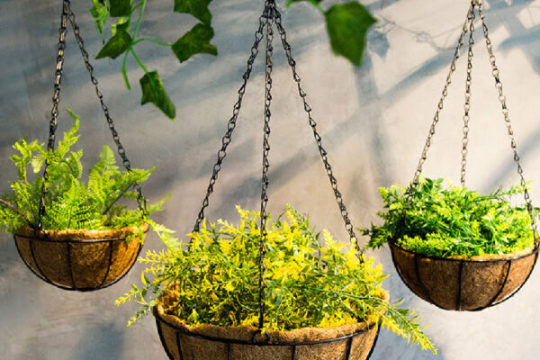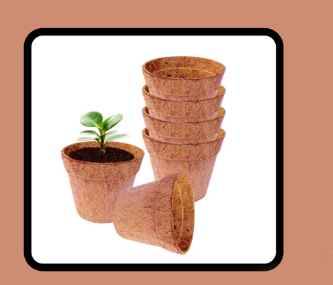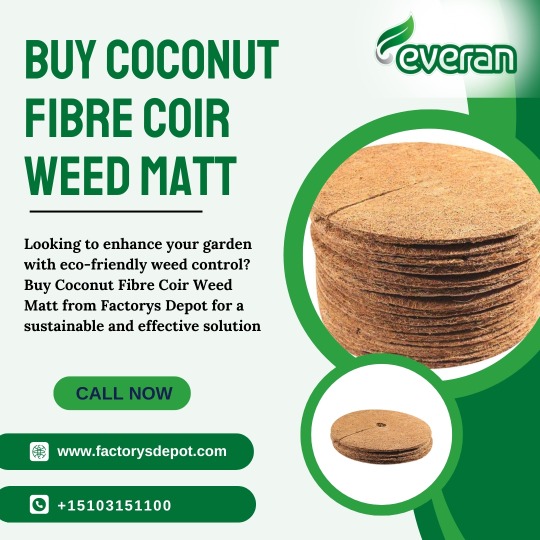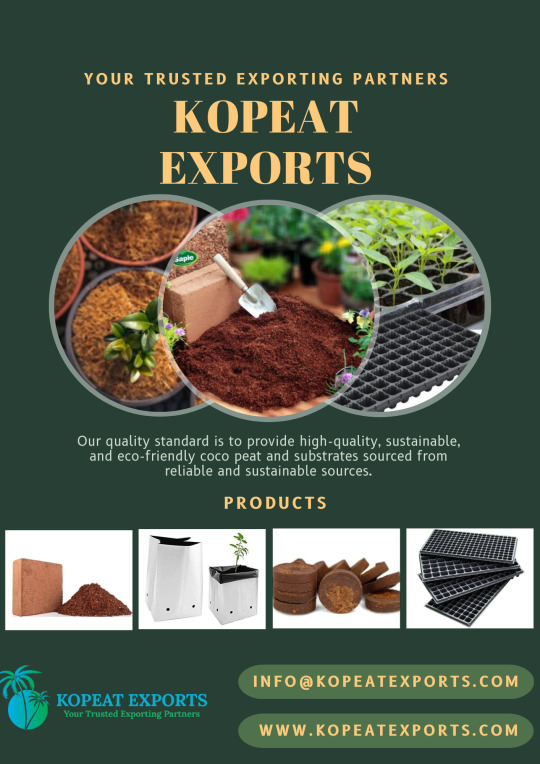#coir fibre
Explore tagged Tumblr posts
Text
Coco Coir Pots
Title: Harnessing the Green Magic of Coco Coir Pots for Sustainable Gardening
Introduction: Coco coir pots, the eco-friendly alternative to traditional plant containers, are taking the gardening world by storm. These biodegradable pots, derived from coconut husk fiber, offer numerous benefits for both garden enthusiasts and the environment. In this blog post, we'll delve into the world of coco coir pots exploring their many advantages and how they contribute to sustainable gardening practices.
Understanding Coco Coir Pots: Coco coir pots, also known as coir pots or coir planters, are made from coconut coir, a natural fiber extracted from coconut husks. Unlike plastic or clay pots, coco coir pots are biodegradable and have a unique ability to enhance plant growth.

Advantages of Coco Coir Pots: Let's explore some of the key benefits of using coco coir pots in your gardening endeavors:
Biodegradability: One of the most significant advantages of coco coir pots is their biodegradability. These pots break down naturally over time, eliminating the need for disposal and reducing environmental waste.
Reduced Transplant Shock: When it's time to transplant your seedlings or young plants, you can plant the entire coco coir pot directly into the soil. This reduces transplant stress and minimizes root disturbance, ensuring a smoother transition for your plants.
Improved Aeration: The porous nature of coir promotes aeration and air pruning of roots. This leads to healthier root development, as roots are encouraged to grow within the pot and not become root-bound.
Enhanced Moisture Retention: Coco coir is excellent at retaining moisture, which means you won't need to water your plants as frequently. It provides a consistent and steady supply of moisture to the roots.
pH Neutral: Coco coir has a neutral pH level, making it suitable for a wide range of plants. You can easily adjust the pH to match specific plant needs.
Eco-Friendly Alternative: Choosing coco coir pots supports eco-friendly gardening. By opting for biodegradable containers, you reduce plastic waste and minimize the environmental impact of traditional plastic pots.
Versatility: Coco coir pots come in various sizes, making them suitable for different types of plants, from small seedlings to larger ornamental trees. They can be used in both indoor and outdoor gardening.
youtube
Additional Uses of Coco Coir Pots: Coco coir pots aren't limited to just planting. Here are some other applications:
Mulching: Coir pots can be used as mulch. When placed on the soil's surface, they help retain moisture, regulate soil temperature, and reduce weed growth.
Composting: When your coco coir pots are no longer needed, you can add them to your compost pile. They'll break down and enrich the compost with organic matter.
Craft Projects: The natural texture and appearance of coco coir make it a great material for various craft and art projects. Get creative and use coir in your DIY endeavors.

Conclusion: Coco coir pots are a game-changer for sustainable gardening. Their biodegradability, reduced transplant shock, and ability to improve plant growth make them a valuable asset for gardeners. By choosing these eco-friendly alternatives to traditional plant containers, you not only promote healthier plant growth but also contribute to a greener and more sustainable future. Whether you're an avid gardener or just starting out, consider making the switch to coco coir pots and witness the green magic they bring to your garden.
#Coir Dust#Coir Pith#Coco Peat#Long Type Grow Bag#Grow Slab#Coconut Coir Pith#Coir Pith Near Me#Pith Coconut#Coco Pith Near Me#Coir Fibre Pith#Coconut Husk Pith#Coco Coir Pots#Coco Soil#Coconut Fiber For Plants#Coco Pot#Coir Pots For Plants#Peat Grow Bags#Youtube
2 notes
·
View notes
Text

Buy Coconut Fibre Coir Weed Matt at Factorys Depot
Looking to enhance your garden with eco-friendly weed control? Buy Coconut Fibre Coir Weed Matt from Factorys Depot for a sustainable and effective solution. Our high-quality coir mats suppress weeds while allowing your plants to thrive. Shop now and experience the natural benefits of coconut fibre!
Read more on:https://factorysdepot.com/product/coir-weed-mat/
#factorys depot#coconut coir#coco coir#everan international#Buy Coconut Fibre Coir Weed Matt#Coir Weed Matt
0 notes
Text

Coir Fibre Manufacturers | Coco Coir Manufacturers in India
Meadowindia is one of the best coir fiber manufacturers companies in India. Coir Fiber produce and supplies natural, biodegradable fiber extracted from the outer husk of coconuts for use in agriculture and horticulture.
0 notes
Text









Nala Wallpapers
This collection is a subtle tribute to the romance and adventure of classic tented safaris. Featuring wallpapers with soft tones and linen textures in various animal prints and designs. The neutral palette of brown, beige, cream, and gold offers the calm and serene aesthetic of an untouched wilderness that instils a sense of refined luxury. There are 15 different wallpapers, found in wallpapers in the game catalogue.
HERE
Nala flooring features natural fibre carpets made from seagrass, sisal, coir, and jute, and is available HERE
#s4cc#ts4 cc#s4wallpaper#s4build decor#s4 download#s4wall#s4#ts4cc#tilly tiger sims 4#simblr#sims4cc#sims 4 download
36 notes
·
View notes
Note
Another world building ask but how big do you think coir/ coconut fibre processing is in ACT. It doesn’t really make any put nay mention of it but from just a sheer world built in perspective it seems like something they’d feasibly do if they had any reason for fiber crafts
yeah i agree I doubt itd be like... a major thing especially with settlements father undersea/how long the trash economy has been the standard, but I could totally see the potential of terrestrial crab societies or even floating societies doing coconut fiber production. i've seen some very cute crab and hermit crab hides made from the entire coconut husk, it feels like a very obvious material to use
3 notes
·
View notes
Note
Hi! Thank you for the new chapter! I'd like to ask about a few things! On p. 216, the woodcutter mentions "mountain tea", and he also wears a "coir coat". Are these cultural mainstays? Likewise, are "seas of scandal" and "fields of mouth and tongue" anything? Very queer formulations, so they stood out! Anyway, I liked it. Very bucolic! The idealization of the "unlettered spouse" was quite unexpected and charming.
Hello!
This is the first song that you're refering to:
On tall, craggy peaks that touch heaven’s edge A grass house, a straw hut would make up my home. Cured fowls, smoked geese surpass turles or crabs; Hares, antelopes, and deer best fishes or shrimps. The scented chun leaves; The yellow lian sprouts; Bamboo shoots and mountain tea are even better! Purple plums, red peaches, prunes and apricots ripe, Sweet pears, sour dates, and cassia flowers.”
And this is part of the second:
And barter them for wine I drink till drunk. A coir coat shrouds me, on autumnal stream I lie; Snoring, asleep, No fret or care— I love not the glory or the pomp of man.”
Mountain tea is an oolong tea that is produced in the mountains indeed. The most famous variety is that produced in the Wuyi Mountains in the east of China, in Fujian, but there might be some mountain tea produced in the mountains around Chang'An in that era :) I myself drink mountain tea (imported) and it's really good, so yeah, I think it's a mainstay. However, I don't know what to tell you about the coir coat. Coconuts are originally from the Austronesian cultures but it's possible that by the Tang Dynasty, when the story takes place, they might have adopted the use of that fibre for clothes. This is the only source I've found about the use of coir, but for ships! But they were used for sure in the Ming Dynasty (when the book was written). Source here.


The last thing you're refering to: I sprawl on grassy paths when wild swans cry. I have no stake in fields of mouth and tongue; Through seas of scandal I’ve not made my way.
I think this is quiet easy to interpret :) He simply means that he doesn't like useless chatter and gossip, but he said that using a metaphor. Just like if you said "she has pearls in her mouth" you mean that her teeth are white.
According to a book about taoism that I have, "There are three great causes of illness: excessive sexual activity, grasping after wealth and material things, and gossip and slander"
"The sagely leaders who embraced the Tao had a particular way of governing their country. They covered their ears and did not listen to gossip; they covered their eyes and were not confused by illusions."
10 notes
·
View notes
Text
Pyramid International Tweety, One Size | masr356.com
Price: (as of – Details) Pyramid International brings you an impressive range of coir door mats to keep your floors clean. Made from durable, natural coconut fibre matting with a robust non-slip backing, these doormats are perfect for both indoor and outdoor use. We offer an extensive collection of mats inspired by popular films, television shows, games, and more, so you can find the perfect…
0 notes
Text

#Agricultural grow lights#Lettuce grow hydroponic garden#Best Potting mix home depot#Best indoor potting mix#Best potting mix for indoor plants
0 notes
Text
Which Mattress Is Best For Kerala Climate?
Kerala’s high humidity requires a precise selection of mattresses to ensure a comfortable night’s sleep. Increased humidity requires mattresses that provide proper ventilation and are risk-free against heat, mould, and dust mite infestations. This post offers some details about the top Kerala mattress choices.
Latex Mattresses: The Top Choice
A natural latex mattress is most suitable for the Kerala climate. Its open cell structure makes air circulate freely and avoids generating heat. Furthermore, latex is moisture absorbing, and by nature, it is relatively free from dust mites, thus keeping the bed clean. Based on these qualities, latex is referred to as the best mattress in Kerala.
There is a wide range of densities and comfort levels that should be balanced if you are shopping for a latex mattress. Make sure that the outer layer of the mattress does not retain heat. Also, check that it does not accumulate perspiration.
Coir Mattresses: A Traditional Alternative
In Kerala, coir mattresses are used most. They are derived from coconut fibre and are supportive and allow for proper circulation of air within them. Their structure ensures that heat and moisture can be let out, allowing you to stay cool. Casting aside the durability of the latex, a coir mattress is, again, relatively cheaper and ideal for the weather of Kerala.
Hybrid Mattresses: A Modern Solution
The features include the use of latex or foam gel in addition to the coil system; hence, the term hybrid mattress is preferred since it is both healthy and breathable. They are perfect for those who do not wish to have a loose or tight top and bottom and feel that their mouth is restricted too much.
Further, when looking for hybrids, you should search for ones that incorporate gel-infused foam layers for added measure in cooling effectiveness.
Memory Foam: A Cautious Choice
Memory foam mattresses provide correct pressure point relief but can be hot. The gel-infused or ventilated memory foam is more appropriate to use in the Kerala climate since it enhances ventilation.
Innerspring Mattresses: Simple Yet Effective
An innerspring mattress permits good air circulation as there are spaces between coils present. Though they do not have the venting properties of latex or memory foam, those mattresses mean the heat can be a problem in Kerala’s climate.
Factors to Consider
The major factors to consider when choosing the right Kerala mattress are:
Cooling Features
Durability
Firmness Level
Testing
Conclusion
Deciding on the best mattress in Kerala is about picking the right balance of a mattress that can breathe as well as hold up and endure for long. In terms of comfort and hygiene, latex mattresses remain unrivalled; thus, it can be said that latex mattresses are the right pick for all.
Nestin by PYARE LAL FOAMS PRIVATE LIMITED provides the best mattress to meet your requirements. As the largest Indian manufacturer, the company guarantees the finest quality at what can be factory gate prices. Feel fresh and comfortable sleep in the difficult climate of Kerala using latex, hybrid, and coir mattresses they make.
#nestin mattress#buy mattress online#online mattress shopping#mattress in kerala#best mattress in kerala
0 notes
Text

Ever wondered if you can throw your door mats in the washing machine? It’s not always that simple! Synthetic mats like nylon and polyester? Often fine, but natural coir ones? That’s a whole different story. Learn the best ways to clean and care for door mats, from choosing the right machine settings to alternative cleaning methods for delicate materials. Plus, find out how to avoid mould when drying!
Read more:
0 notes
Text
Revolutionizing the Construction: Fiber-Reinforced Concrete Additives
Concrete is one of the most widely used materials in construction with a good compression ability and excellent versatility. But some disadvantages exist in traditional concrete. It is prone to cracking, exhibits poor tensile strength, and loses its strength in adverse environmental conditions. The appearance of fiber-reinforced concrete additives marks a big leap in the advancement that enhances concrete's performance and durability significantly, allowing it to be used widely in various fields.
What is Fiber-Reinforced Concrete?
Fiber-reinforced concrete, or FRC, is one of the types of concrete where fibrous ingredients are used to enhance the mechanical properties of the former. These fibers, derived from materials like steel, glass, synthetic products, and even natural sources, provide supplemental reinforcement, thus enhancing tensile strength and crack resistance within the concrete.
These fibers distribute stress more evenly and, upon addition to the concrete mix, reduce the formation of micro-cracks and inhibit crack propagation. This yields a much more durable and versatile material that can resist more significant loads and adverse environmental conditions.
Categories of Fiber-Reinforced Concrete Additives
Steel Fibers
Steel fibers are extensively utilized due to their strength and resilience. They enhance the impact resistance and load-bearing ability of concrete, rendering them particularly suitable for applications such as industrial floors, tunnels, and pavements. Additionally, steel fibers contribute to the improved fatigue resistance of concrete when subjected to cyclic loads.
Glass Fibers
Glass fibers are used in most architectural applications because of their tensile strength and aesthetic appeal. Due to its resistance to alkali and chemicals, it finds conditions with extreme chemical exposure to be suitable.
Artificial Fibres
Synthetic fibers such as polypropylene or nylon are corrosion-resistant and lightweight. It has a good potential to minimize plastic shrinkage cracks and improve the post-cracking behavior of concrete. Synthetic fibers are generally used in residential slabs, precast elements, and thin-section applications.
Organic Fibers: Natural fibers, which are derived from renewable sources such as coconut coir, jute, or hemp, provide an environmentally friendly option. These fibers enhance the strength and cracking resistance of concrete while promoting sustainable construction practices.
Advantages of fiber-reinforced concrete additives:
Improved Durability: Fibers provide concrete with crack resistance and increased toughness, thereby reducing maintenance and repairs.
Improved Tensile Strength: The addition of fibers increases the tensile and flexural strength of concrete, thus allowing it to withstand greater loads.
Resistance to Cracking: Fibers help in controlling plastic shrinkage and thermal cracks, thereby improving the structural integrity.
Versatility: Suitable for various applications, ranging from industrial flooring to architectural elements.
Cost Efficiency: Reduces the need for additional reinforcement, which reduces construction costs.
Use of Fiber-Reinforced Concrete Additives
Industrial Flooring: High-strength concrete mixed with steel fibers is best utilized for heavy-load areas in the warehouses and factories.
Bridges and Tunnels: Fibers increase the service life and resistance to cracking for structures subjected to dynamic loads.
Residential Construction: Synthetic fibers don't crack in slabs, driveways, and patios.
Marine Structures: Glass fibers enhance resistance to chloride-induced corrosion in marine environments.
Precast Elements: Fibers strengthen the tensile strength and dimensionally stability of precast concrete products. Developments and Challenges Despite these advantages, there are challenges relating to the cost of the additive, fiber distribution, and compatibility with the mix design of conventional concrete. Current research has been able to develop advanced fiber-blending techniques and hybrid fibers, with the latter focusing on using several types of fibers together in a hybrid system for improving performance, strength, durability, and cost-effectiveness. Conclusion Additives based on fiber reinforcement are revolutionizing the construction sector by mitigating the shortcomings inherent in conventional concrete. In various domains, including infrastructure, residential developments, and industrial uses, these additives significantly improve durability, strength, and adaptability, thereby guaranteeing that structures endure over time. With ongoing progress in fiber technology, the possibilities for fiber-reinforced concrete in fostering sustainable and resilient building practices are expanding, thereby laying the groundwork for a future characterized by longevity.
0 notes
Text
How to Use Coconut Coir Pith in your Garden?
Using coconut coir pith, also known as coco peat or coir dust, in your garden offers several benefits, including water retention, aeration, and soil conditioning. Here's a step-by-step guide on how to use coconut coir pith effectively in your garden:
Procure Coconut Coir Pith:
Purchase coconut coir pith from gardening stores, nurseries, or online suppliers. It is commonly available in compressed bricks or blocks.
Rehydrate the Coir Pith:
Place the compressed coir pith bricks in a large container or tub.
Add water to the container, allowing the coir pith to absorb moisture and expand.
Allow the coir pith to soak in water for several hours or overnight until fully rehydrated.
Mix with Soil or Potting Mix:
Once fully rehydrated, fluff up the coir pith with your hands to loosen it.
Mix the rehydrated coir pith with your garden soil or potting mix in a ratio of 1:1 or as desired. Alternatively, you can use coir pith as a soilless growing medium.

Use as Soil Amendment:
Incorporate the rehydrated coir pith into your garden soil as a soil amendment to improve its structure, moisture retention, and aeration.
Dig the coir pith into the soil to a depth of a few inches, ensuring even distribution throughout the garden bed.
Mulching:
Spread a layer of rehydrated coir pith on the soil surface around plants as mulch.
Mulching with coir pith helps conserve soil moisture, suppresses weed growth, and regulates soil temperature.
Seed Starting and Container Gardening:
Use rehydrated coir pith as a growing medium for starting seeds indoors or in seed trays.
Fill seed trays or pots with a mixture of coir pith and perlite or vermiculite for optimal seed germination and seedling growth.
Hydroponic and Aquaponic Systems:
Rehydrated coir pith can also be used as a growing medium in hydroponic and aquaponic systems.
Place the coir pith in growing containers or hydroponic trays and use it to grow plants without soil.
youtube
Watering and Maintenance:
Water your garden regularly to ensure adequate moisture levels, especially when using coir pith as a soil amendment or mulch.
Monitor the moisture levels in the soil and adjust watering as needed to prevent waterlogging or dryness.
Sustainable Disposal:
Coconut coir pith is a sustainable and biodegradable material. After use, it can be composted along with other organic waste to enrich the soil.
By following these steps, you can effectively use coconut coir pith in your garden to improve soil structure, retain moisture, and promote healthy plant growth.
#Coir Dust#coco coir pots#coco soil#coco peat#coir pots for plants#coco pith near me#coco pith#coco pot#coconut fiber for plants#coconut husk pith#coir fibre pith#Peat Grow Bags#Coir Pots For Plants#Coco Pot#Youtube
1 note
·
View note
Text
Easy Solution to Weed Control | Coir Weed Mats
#factorys depot#coconut coir#coco coir#everan international#coir weed mat#fibre coir weed mat#buy coconut coir
0 notes
Text
Coir Fibre Manufacturers | Coco Coir Manufacturers in India
Meadowindia is one of the best coir fiber manufacturers companies in India. Coir Fiber produce and supplies natural, biodegradable fiber extracted from the outer husk of coconuts for use in agriculture and horticulture.
0 notes
Text
Geotextile Market
Geotextile Market Size, Share, Trends: Koninklijke TenCate Lead
Rising adoption of sustainable geotextiles
Market Overview:
The global geotextile market is expected to grow at a CAGR of 10.3% from 2024 to reach USD XX million by 2024 and USD YY million by 2031. Asia-Pacific is the dominant region in the market. The growth of the geotextile market is driven by increasing investments in infrastructure development, growing environmental concerns, and rapid urbanization. Geotextiles are widely used in road construction, erosion control, and railroad work due to their excellent filtration, separation, and reinforcement properties. The market is also witnessing technological advancements and new product launches that are further fueling growth.
DOWNLOAD FREE SAMPLE
Market Trends:
There is a rising preference for sustainable and environmentally friendly geotextiles derived from natural fibres such as jute, coir, and sisal. These geotextiles are biodegradable and have a smaller carbon impact than synthetic geotextiles. Manufacturers are focussing on creating novel sustainable geotextiles to meet the growing demand from environmentally conscious consumers and stricter environmental requirements.
Market Segmentation:
The non-woven segment is expected to dominate the geotextile market during the forecast period. Nonwoven geotextiles are widely employed in a variety of applications due to their high permeability, filtration, and separation capabilities. The segment's rise is being driven by increased demand for road construction and erosion control applications.
TenCate Geosynthetics recently announced TenCate Mirafi RSi, a novel non-woven geotextile with improved mechanical and hydraulic qualities for demanding soil reinforcement applications. To meet rising demand, the company has installed a new non-woven geotextile production line at its location in Georgia, USA.
According to our research analysis, global demand for non-woven geotextiles is predicted to grow by 4.5% per year through 2024, reaching 1.7 billion square meters. The report also states that the Asia-Pacific region will account for the majority of the growth, driven by increased infrastructure building initiatives in nations such as China and India.
Market Key Players:
Koninklijke TenCate
GSE Environmental
NAUE GmbH & Co. KG
Officine Maccaferri
Low & Bonar
Propex Operating Company
Contact Us:
Name: Hari Krishna
Email us: [email protected]
Website: https://aurorawaveintellects.com/
0 notes
Text
0 notes